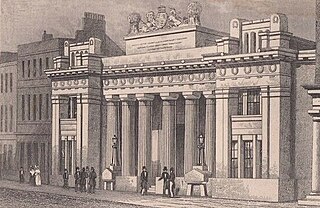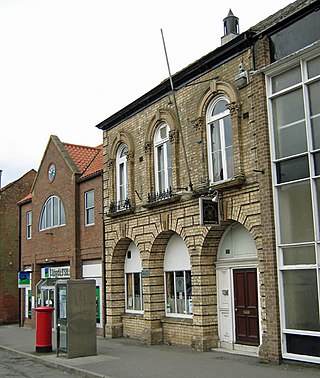
A commodity market is a market that trades in the primary economic sector rather than manufactured products, such as cocoa, fruit and sugar. Hard commodities are mined, such as gold and oil. Futures contracts are the oldest way of investing in commodities. Commodity markets can include physical trading and derivatives trading using spot prices, forwards, futures, and options on futures. Farmers have used a simple form of derivative trading in the commodity market for centuries for price risk management.

The Agricultural Adjustment Act (AAA) was a United States federal law of the New Deal era designed to boost agricultural prices by reducing surpluses. The government bought livestock for slaughter and paid farmers subsidies not to plant on part of their land. The money for these subsidies was generated through an exclusive tax on companies that processed farm products. The Act created a new agency, the Agricultural Adjustment Administration, also called "AAA" (1933–1942), an agency of the U.S. Department of Agriculture, to oversee the distribution of the subsidies. The Agriculture Marketing Act, which established the Federal Farm Board in 1929, was seen as an important precursor to this act. The AAA, along with other New Deal programs, represented the federal government's first substantial effort to address economic welfare in the United States.

The British Agricultural Revolution, or Second Agricultural Revolution, was an unprecedented increase in agricultural production in Britain arising from increases in labor and land productivity between the mid-17th and late 19th centuries. Agricultural output grew faster than the population over the hundred-year period ending in 1770, and thereafter productivity remained among the highest in the world. This increase in the food supply contributed to the rapid growth of population in England and Wales, from 5.5 million in 1700 to over 9 million by 1801, though domestic production gave way increasingly to food imports in the 19th century as the population more than tripled to over 35 million.

Canadian historians until the 1960s tended to focus on the history of Canada's economy because of the far fewer political, economic, religious and military conflicts present in Canadian history than in other societies. Many of the most prominent English Canadian historians from this period were economic historians, such as Harold Innis, Donald Creighton and Arthur R. M. Lower.

The Leeds Corn Exchange is a shopping mall in Leeds, West Yorkshire, England. The structure, which was commissioned as a corn exchange, is a grade I listed building.

The history of agriculture in the United States covers the period from the first English settlers to the present day. In Colonial America, agriculture was the primary livelihood for 90% of the population, and most towns were shipping points for the export of agricultural products. Most farms were geared toward subsistence production for family use. The rapid growth of population and the expansion of the frontier opened up large numbers of new farms, and clearing the land was a major preoccupation of farmers. After 1800, cotton became the chief crop in southern plantations, and the chief American export. After 1840, industrialization and urbanization opened up lucrative domestic markets. The number of farms grew from 1.4 million in 1850, to 4.0 million in 1880, and 6.4 million in 1910; then started to fall, dropping to 5.6 million in 1950 and 2.2 million in 2008.
The grain trade refers to the local and international trade in cereals such as wheat, barley, maize, and rice, and other food grains. Grain is an important trade item because it is easily stored and transported with limited spoilage, unlike other agricultural products. Healthy grain supply and trade is important to many societies, providing a caloric base for most food systems as well as important role in animal feed for animal agriculture.

The Minneapolis Grain Exchange (MGEX) is a commodities and futures exchange of grain products. It was formed in 1881 in Minneapolis, Minnesota, United States as a regional cash marketplace to promote fair trade and to prevent trade abuses in wheat, oats and corn. MGEX became a subsidiary of Miami International Holdings after the two companies merged in 2020.

The Corn Exchange is an events and concert venue located in the Market Place in Newbury, Berkshire, England. The structure, which was commissioned as a corn exchange and is now used as an events venue, is a Grade II listed building.

The Exchange is a Grade I listed building built in 1741–43 by John Wood the Elder, on Corn Street, near the junction with Broad Street in Bristol, England. It was previously used as a corn and general trade exchange but is now used as offices and it also accommodates St Nicholas Market.

The Palace Theatre & Grand Hall Complex is a multi-purpose entertainment arena complex in Green Street, Kilmarnock, Scotland. The structure, which was originally opened as a corn exchange, is a Category A listed building.

The Edinburgh Corn Exchange is an events and concert venue located in New Market Road in Edinburgh, Scotland. The structure, which was commissioned as a corn exchange, is a Category B listed building.
The post-Napoleonic Depression was an economic depression in Europe and the United States after the end of the Napoleonic Wars in 1815. In England and Wales, an agricultural depression led to the passage of the Corn Laws, and placed great strain on the system of poor relief inherited from Elizabethan times.
The great depression of British agriculture occurred during the late nineteenth century and is usually dated from 1873 to 1896. Contemporaneous with the global Long Depression, Britain's agricultural depression was caused by the dramatic fall in grain prices that followed the opening up of the American prairies to cultivation in the 1870s and the advent of cheap transportation with the rise of steamships. British agriculture did not recover from this depression until after the Second World War. Other countries in Western Europe such as the Netherlands experienced the same agricultural crisis (1878–1895) as a result of the market being flooded by cheap grain from the United States and Canada.

İzmir Commodity Exchange (ICE) is a commodities exchange based in İzmir, Turkey. It was the first commodities exchange established in Turkey and focuses on agricultural products. It functions in accordance with the Turkish Law No. 5174 regarding the Union of Chambers and Commodity Exchanges of Turkey and the Chambers and Commodity Exchanges.

The Sioux City Grain Exchange (SCGX) was a cash commodity market in Sioux City, Iowa that primarily traded corn, wheat, oat, and soybean. It was established in 1907 as the Sioux City Board of Trade, named the "fastest growing grain market in the world" in 1929, and among the largest exchanges in the world by the 1970s; transacting over 100 million bushels annually. It served the Corn Belt and primarily competed against the Chicago Mercantile Exchange, Minneapolis Grain Exchange and Kansas City Board of Trade. SCGX's rise and decline was driven by barge navigation of the Missouri River and mirrored the Sioux City Livestock Exchange, the largest in the world during the 1970s. Both were co-founded by Vermont banker Fred L. Eaton.

The Corn Exchange is a retail building in the Market Place, St Albans, Hertfordshire, England. The structure, which is now used to accommodate a pair of shops, is a locally listed building.

The Corn Exchange was a commercial building in Mark Lane, London, England. The original structure dated from 1747, but the exchange later amalgamated with a rival exchange and was rebuilt several times before finally closing in 1987.

The Corn Exchange is a commercial building in Drury Lane in Liverpool, Merseyside, England. The structure has been converted into apartments and studios.

The Corn Exchange is a commercial building in the Market Place in Barton-upon-Humber, Lincolnshire, England. The structure, which is now used as a private members club, is a Grade II listed building.




















